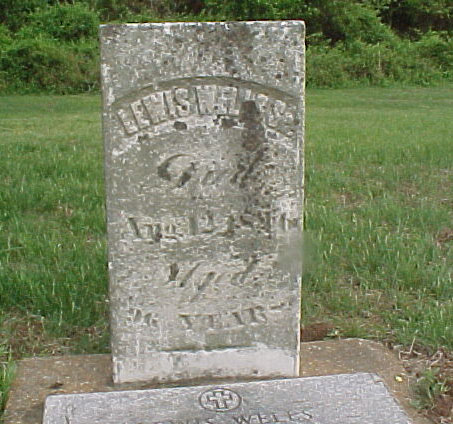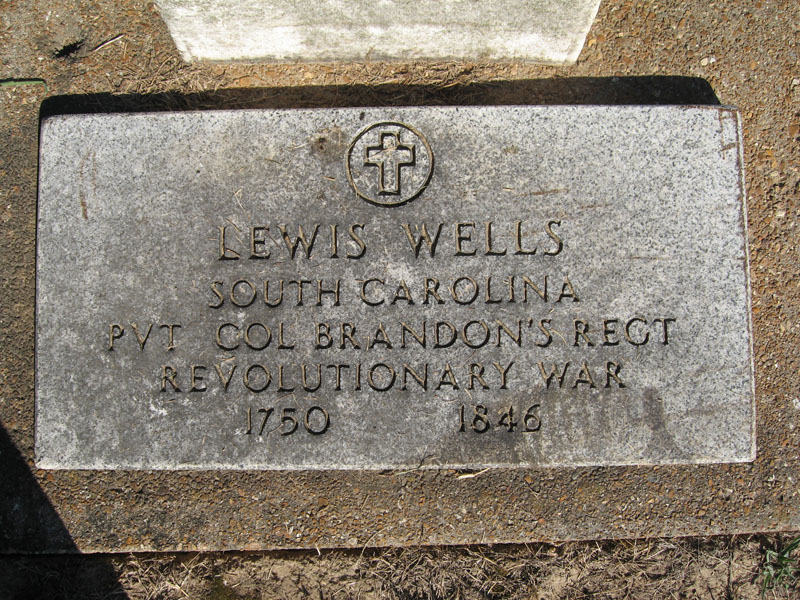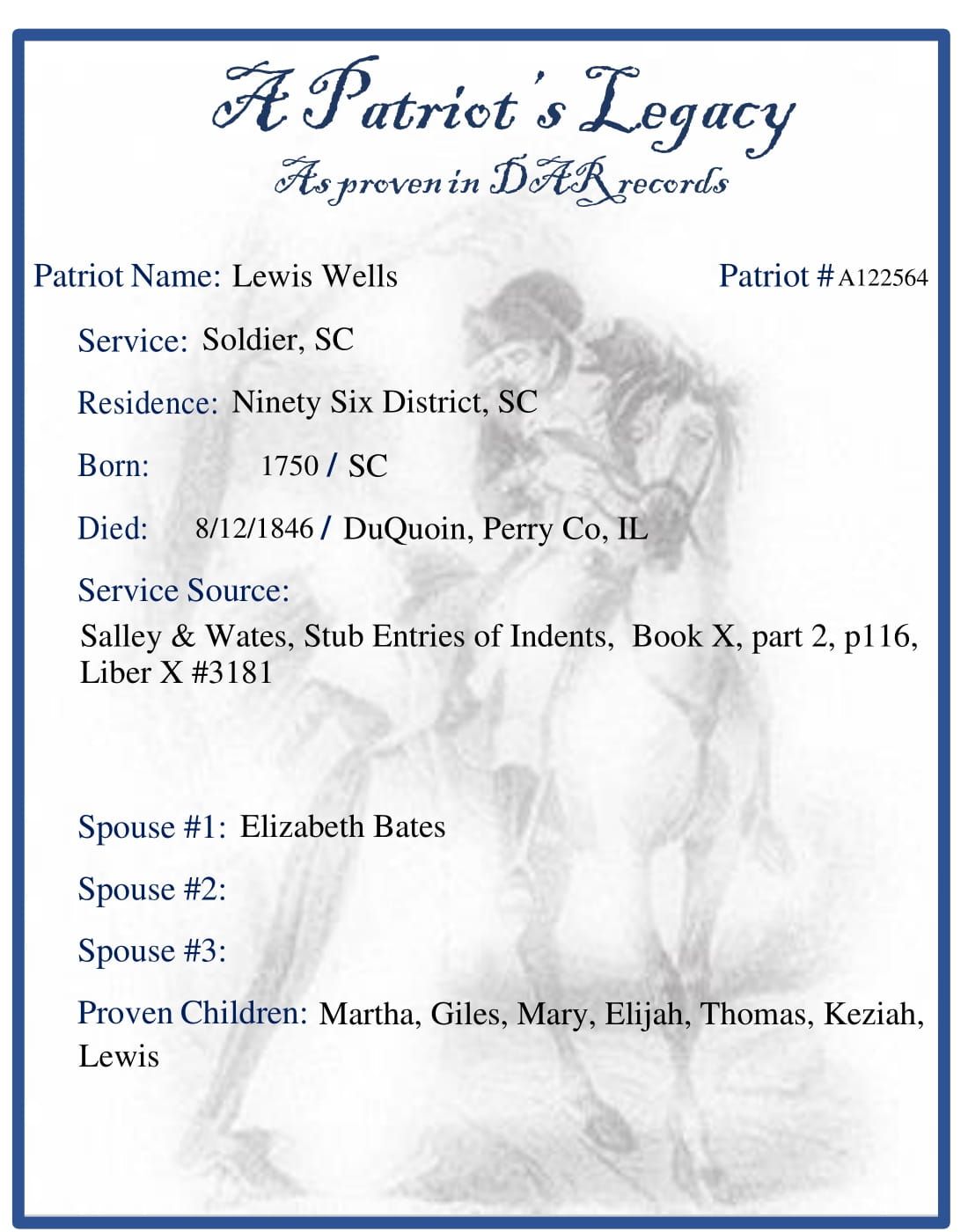At age three, Lewis' maternal grandfather, John Cole, deeded him land in Lunenburg Co., VA. After his father's death, his mother, Susannah, was remarried to William Gamblin and they moved, with Lewis, from Virginia, to Chatham Co., NC., Lewis later lived in Union Co., SC (where he married Elizabeth Bates), and in Greenville, Co., SC. In the 1790 and 1800 US Censuses in Greenville County, the family of William Gamblin, his step-father, was in close proximity.
AMERICAN REVOLUTION: Lewis served in Colonel Brandon's South Carolina Militia Regiment after the fall of Charleston on May 12, 1780. Their most famous battle was The Battle of the Cowpens, 17 Jan 1781: Col. Andrew Pickens led a force of militia units under the command of Brig. Gen. Daniel Morgan and his Continentals at The Battle of Cowpens. Four militia battalions formed the first line and central core of the militia formation. The Fair Forest Regiment of Col. Thomas Brandon, along with Hayes' Little River Regiment, Thomas' Spartanburg Regiment, and Roebuck's Spartanburg Battalion met the initial onslaught of the British under the hated Banastre Tarleton.
According to eyewitness accounts, Brandon's Fair Forest soldiers were the first ones to fire on the advancing British, and the only ones who had sufficient time to reload and to take a second shot. They then, according to plan, made a quick retreat behind Morgan's Continentals, drawing the British into their range. The militia regiments then reformed and rejoined the fight. Many accounts exist of Fair Forest soldiers wounded in hand-to-hand fighting. Local tradition says that Thomas Brandon set the example for his men by killing three British dragoons with his sword.
The defeat of the British at Cowpens finally drove Cornwallis and his army out of the Carolinas.
The movie, "The Patriot" with Mel Gibson is a fictionalized version of that battle.
In 1786, Lewis received "6 Pounds, 17S/1D1/2 Sterling For Duty Done In Brandon's Regiment After The Fall Of Charleston And Anderson's Return.A.A.8351;X3181."
Tradition has it that, in 1803, Lewis Wells, Thomas Taylor, the three Pyle brothers, Robert McElvain and possibly others came to Illinois to assess the land and the Indian situation. They returned to Christian County, Kentucky because of Indian hostility. In 1812, some of the group moved into Illinois with their families, settling first near a fort about four miles east of Carbondale, on Crab Orchard Creek, then, later in Perry Co. The 1812 date which is sometimes cited may be a little early for Wells. In 1817, Lewis and Elizabeth sold 514 acres of land in Christian County, Kentucky, part of which they had purchased from Abner Pyle in 1812. This might indicate that the Pyles moved first, and the Wells family followed a few years later.
Lewis and Elizabeth were the parents of Lewis Jr., Thomas Bates, Susan, Elijah, Martha Ann (Williams), Sarah (Pyle), Kiziah (McElvain), Mary (Pyle), Elizabeth Bates (Winters), Joseph and Giles.
Many of the burials in McElvain Cemetery are early pioneers of Perry County, and they include many descendants and in-laws of the Wells.
This biography was written by Bonnie Ward Williamson. If you do a "copy and paste" of it, please include that information.
RESEARCH NOTES: Sources for this biography, including military histories, copies of some original documents, etc. are available; just contact me.
At age three, Lewis' maternal grandfather, John Cole, deeded him land in Lunenburg Co., VA. After his father's death, his mother, Susannah, was remarried to William Gamblin and they moved, with Lewis, from Virginia, to Chatham Co., NC., Lewis later lived in Union Co., SC (where he married Elizabeth Bates), and in Greenville, Co., SC. In the 1790 and 1800 US Censuses in Greenville County, the family of William Gamblin, his step-father, was in close proximity.
AMERICAN REVOLUTION: Lewis served in Colonel Brandon's South Carolina Militia Regiment after the fall of Charleston on May 12, 1780. Their most famous battle was The Battle of the Cowpens, 17 Jan 1781: Col. Andrew Pickens led a force of militia units under the command of Brig. Gen. Daniel Morgan and his Continentals at The Battle of Cowpens. Four militia battalions formed the first line and central core of the militia formation. The Fair Forest Regiment of Col. Thomas Brandon, along with Hayes' Little River Regiment, Thomas' Spartanburg Regiment, and Roebuck's Spartanburg Battalion met the initial onslaught of the British under the hated Banastre Tarleton.
According to eyewitness accounts, Brandon's Fair Forest soldiers were the first ones to fire on the advancing British, and the only ones who had sufficient time to reload and to take a second shot. They then, according to plan, made a quick retreat behind Morgan's Continentals, drawing the British into their range. The militia regiments then reformed and rejoined the fight. Many accounts exist of Fair Forest soldiers wounded in hand-to-hand fighting. Local tradition says that Thomas Brandon set the example for his men by killing three British dragoons with his sword.
The defeat of the British at Cowpens finally drove Cornwallis and his army out of the Carolinas.
The movie, "The Patriot" with Mel Gibson is a fictionalized version of that battle.
In 1786, Lewis received "6 Pounds, 17S/1D1/2 Sterling For Duty Done In Brandon's Regiment After The Fall Of Charleston And Anderson's Return.A.A.8351;X3181."
Tradition has it that, in 1803, Lewis Wells, Thomas Taylor, the three Pyle brothers, Robert McElvain and possibly others came to Illinois to assess the land and the Indian situation. They returned to Christian County, Kentucky because of Indian hostility. In 1812, some of the group moved into Illinois with their families, settling first near a fort about four miles east of Carbondale, on Crab Orchard Creek, then, later in Perry Co. The 1812 date which is sometimes cited may be a little early for Wells. In 1817, Lewis and Elizabeth sold 514 acres of land in Christian County, Kentucky, part of which they had purchased from Abner Pyle in 1812. This might indicate that the Pyles moved first, and the Wells family followed a few years later.
Lewis and Elizabeth were the parents of Lewis Jr., Thomas Bates, Susan, Elijah, Martha Ann (Williams), Sarah (Pyle), Kiziah (McElvain), Mary (Pyle), Elizabeth Bates (Winters), Joseph and Giles.
Many of the burials in McElvain Cemetery are early pioneers of Perry County, and they include many descendants and in-laws of the Wells.
This biography was written by Bonnie Ward Williamson. If you do a "copy and paste" of it, please include that information.
RESEARCH NOTES: Sources for this biography, including military histories, copies of some original documents, etc. are available; just contact me.
Family Members
Advertisement
Records on Ancestry
Advertisement

















